
Our 80th Anniversary: How we got here
Canadian Plastics
Canadian PlasticsCanadian Plastics magazine turns 80 this summer, and what a long, strange trip it’s been. Here’s a look at our industry from World War II to COVID-19, and all the years in between, as we covered it.

Nineteen forty-three was a tumultuous year: World War II was in its fourth year, and factories throughout the West worked around the clock to supply goods for the war effort. There was a tremendous shortage of metal, wood, ceramics, natural fibres and rubber, and as a result, plastics begins to come into its own as a substitute material, as engineers and designers turned to phenolics and other plastic materials to produce hundreds of new products for both the civilian population and the military. And this, in turn, prompts the creation of Canadian Plastics magazine, with its first issue in August 1943. (It then went on hiatus until after the war due to a severe paper shortage, and resumed regular production in 1946.)
No single event had a greater impact on the plastics industry than the war, and this was apparent even at the time. “Canadian use of plastic materials has grown steadily and today is making a valuable contribution to our war production program,” our first editorial said. “Significant, as a result of this, is the new attitude of Canadian industrial designers and engineers toward plastics, and inescapable is the fact that employment of this material is going to take place on a broad manufacturing scale.”
Plastic – from a word that originally meant “pliable and easily shaped” – predated World War II by decades, of course, with the first plastics mainly developed as substitutes for ivory. In 1862, Alexander Parkes introduced “Parkesine,” the world’s first-ever man-made plastic, at the London International Exhibition, marketed as an alternative to ivory and horn that Parks discovered while trying to develop a synthetic substitute for shellac for waterproofing. Following on that, the first synthetic polymer was invented in 1869 by John Wesley Hyatt, who was inspired by a New York firm’s offer of $10,000 for anyone who could provide a substitute for – again – ivory, for use in billiard balls. By treating cellulose, derived from cotton fibre, with camphor, Hyatt discovered a plastic that could be crafted into a variety of shapes and made to imitate a natural substance like ivory, and also tortoiseshell, horn, and linen. In 1872, Hyatt and his brother patented the world’s first injection molding machine.
Fast forward to 1907 and Leo Baekeland invented Bakelite, the first fully synthetic plastic, meaning it contained no molecules found in nature. Marketed as “the material of a thousand uses,” Bakelite could be shaped or molded into almost anything, providing endless possibilities. International developments came regularly after that – in the UK, Rolls Royce started using phenol formaldehyde in its car interiors in 1916, Scotch tape was introduced in the U.S. in 1930, the first twin-screw extruder machine was introduced in Italy in 1936, the first commercial production of polystyrene (PS) began in Germany in 1937. And the industry was also building in Canada: William Zeidler of Toronto was the first Canadian to receive a patent for plastics processing for a method of polishing cellulose nitrate, in 1885; Granby Manufacturing Co., of Granby Que., starting making cellulose nitrate in 1908; Electroplax Ltd., of Toronto, began custom molding phenolic products in 1923; Canadian General Electric Co., of Peterborough, Ont., formed a plastics molding department in 1929; and French Ivory Products, of Toronto, installed the first injection molding machine in North America in 1930.
During World War II, plastic production in Canada and the U.S. increased by 250 and 300 per cent respectively. Nylon, invented by Wallace Carothers in 1935 as a synthetic silk, was used during the war for parachutes, ropes, body armor, helmet liners, and more. Plexiglas provided an alternative to glass for aircraft windows. The surge in plastic production continued after the war ended in 1945; exploded beginning in the 1950s; and became part of the zeitgeist in the 1960s, a moment that was cemented in the 1969 film The Graduate, with its confident prediction that “the future is one word: plastics.”
And as evidenced in thousands of cutting-edge applications in every product sector since then, plastics did indeed become – and still is – the future.
Below is a look at some of the products, trends, events, issues, and news stories that Canadian Plastics has covered over the past eight decades.
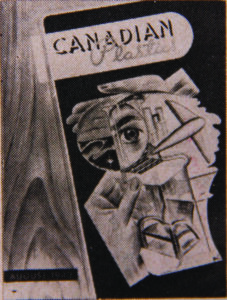
The 1940s
Noteworthy news/events: The Society of Plastics Industry of Canada (SPI Canada) was formed in 1942; Canada Wire & Cable Co. of Toronto produced the first polyethylene (PE) resins in North America; Canada Resins & Chemicals Ltd., of Shawinigan, Que., starts producing PVC; Percy Hermant Ltd. of Toronto produced the first nylon molded product in Canada – a tumbler; Dow Chemical of Canada, in Sarnia, Ont., began production of polystyrene (PS) resins; Wentworth Mold is founded in 1947; Canadian General Rubber Co. installs the first Canadian-built injection molding machine at its plant in Cambridge, Ont.; founding of Toronto Plastics in 1949.
Profitable products: Phone housings; Tupperware LDPE containers; Formica; Lycra.
Significant trends and developments:</b> Large tonnage injection presses; steam-heated molds; development of Alberta’s oil and gas fields.
Hot button issues: Trade with Japan; flammable toys made of cellulose nitrate.
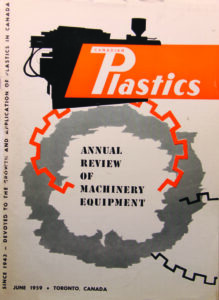
The 1950s
Noteworthy news/events: The formation of the Toronto section of the Society of Plastics Engineers (SPE) in 1950; DuPont Co. of Canada introduces Delrin acetal resin to the Canadian market in 1957; the aftermath of Hurricane Hazel in 1954 floods Woodbridge Moulded Products’ facility with six feet of water; Bolta Plastics Ltd., of Granby, Que., purchases the largest injection molding machine in Canada, an 80 ounce (shot size) HPM, to mold polyethylene (PE) garbage pails; Visking Co., of Lindsay, Ont., installs “the largest piece of equipment in Canada,” an extruder capable of producing rolls of PE film 24 feet wide; the founding in 1954 of Nova Chemicals Corp. in Alberta (originally called Alberta Gas Trunk Line Co. Ltd.); the one-man operation that will become Magna International Inc. gets its first auto parts contract in 1959.
Profitable products: Vinyl tile; the Hula Hoop; the Frisbee by Wham-O; PE bottles for detergent and other products; Lego plastic blocks; Barbie dolls; Eames plastic furniture; polyester fabric; bubble wrap.
Significant trends and developments: The use of chemical additives – for example, plasticizers in vinyl – becomes widespread, enabling compounders and processors to fine-tune the properties of resins; PVC finds wider uses; raw resin manufacturing in Canada increases significantly through the decade.
Hot button issues: Increased importation of foreign-made toys; companies lobby the Tariff Board for increasing tariffs and duties on imported raw materials and plastics products.
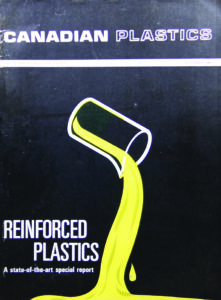
The 1960s
Noteworthy news/events: Polymer Corp. (later Polysar) opened the first Canadian ABS resin manufacturing plant at Sarnia, Ont. in 1964; B.F. Goodrich’s Kitchener, Ont., plant supplies Imperial Oil with 30,000 feet of PVC pipe for its gas fields in Alberta; Imperial Oil buys Polybottle, one of Toronto’s largest blow molders; Union Carbide opens a plastics processing plant in 1964, with a core emphasis on packaging; PE gas tanks introduced by GM Truck and Coach Division in 1967; Expo 67; Neil Armstrong plants a nylon flag on the Moon in 1969.
Profitable products: Bottles, industrial extrusions, household/ kitchen wares, containers and appliances, skylights; TV cabinets; rotationally molded tanks – including hot tubs – and toys; DuPont’s Kevlar.
Significant trends and developments: Screw plastification replaces plunger units on injection molding machines; blow molding technology comes of age; vinyl use expands in automotive and furniture; polystyrene (PS) foam; molding of polypropylene (PP) gains popularity.
Hot button issues: Tariff protection; the 1965 Auto Pact between Canada and the U.S.; and price cutting and “unfair” competition with U.S. plastic processors.
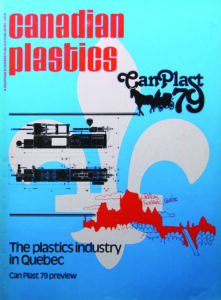
The 1970s
Noteworthy news/events: Union Carbide sells phenolic resins business to Bakelite Thermosets; General Motors orders more Krauss-Maffei presses for its Oshawa molding facility; injection molding machinery manufacturers aren’t able to meet demand for new machines in 1973; late-70s recession hits profits of many molders and moldmakers; Innopac Inc. acquires exclusive rights to produce PET dual-ovenable tray from Plastona Ltd. of England; Mitten Vinyl opens a new 38,000-square-foot plant in Cambridge, Ont., in 1979; plastic in the Canadarm robotic space arm; Husky Manufacturing & Tool Works becomes Husky Injection Molding Systems Ltd. in 1973.
Profitable products: PE stretch film; RIM fascia, plastic grille and bumper components, instrument panel parts in automobiles; multi-layer industrial PE shipping bags; plastic drums, yogurt containers, bathware, patio furniture in consumer goods; BOPP film; PET beverage bottles; hockey equipment; skateboards; kayaks; “living hinges” on bottles connecting two plastic parts.
Significant trends and developments: Raw materials handling and other auxiliary equipment becomes more advanced and more crucial to successful molding; colourant technology expands, offering processors more sophisticated options; structural foam molding sees wider commercial use; introduction of ribbing in PVC pipe adds strength; CAD/CAM software and CNC machining of molds; large-part, technical blow molding evolves into first commercial products; by 1979, plastic production overtook steel production in North America; first commercial mobile/portable telephones; development of polylactic acid (PLA); linear low density polyethylene (LLDPE) commercialized.
Hot button issues: Autonomy for SPI Canada; ozone depletion: blowing agents in EPS; curbside recycling; the 1973 oil embargo.
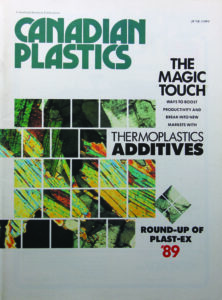
The 1980s
Noteworthy news/events:
Alberta Gas Trunk Line Co. Ltd. renamed Nova Chemicals Corp. in 1980; weak Canadian dollar during the first half of the decade; the first artificial heart made mainly of polyurethane, introduced implanted in a human in 1982; major recession in 1982; Magna International Inc. spends $80 million to build 15 auto plants near Newmarket, Ont., in 1984; first polymer bank notes issued, in Australia, in 1986; IPL expands plant in St.-Damien, Que.; Twinpak opens PET bottle manufacturing facility in Mississauga, Ont.; the Free Trade Agreement (FTA) of 1988; the introduction of triangular recycling symbols relating to plastics.
Profitable products: “Living hinges” on bottles connecting two plastic parts; squeezable plastic bottles; pink plastic flamingos; CDs; the slim plastic Swatch watch made of 51 mainly plastic components.
Significant trends and developments: Six Sigma quality improvement process; 3D printing begins; widespread adopting of the personal computer and fax machine; widespread movement among domestic firms to a Chinese supplier system; development of the gravimetric batch blender; an explosion of new moldmaking operations rapidly turned Canada, and in particular Windsor, Ont., into one of the moldmaking hot spots in North America.
Hot button issues: Concerns about plastic waste gather steam; free trade.
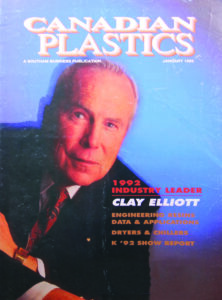
The 1990s
Noteworthy news/events: U.S.-based Versatech purchases Tarxien Corp; extruder Crila Plastics, of Mississauga, Ont., is named one of Canada’s 50 best managed companies by The Financial Post; Brampton Engineering builds and sells first nine-layer blown film line to a company in New Zealand; a devastating ice storm in eastern Ontario and Quebec leaves homes and businesses without power for weeks; Amcor buys Twinpak Inc.; the Canadian Plastics Industry Association (CPIA) is formed from four separate organizations; founding of the Canadian Plastics Training Centre at Humber College in Toronto.
Profitable products: Plastic lumber; plastic corks; nylon intake manifolds; pick-up truck bed liners; auto body moldings; thermoformed packaging; Dyson vacuum cleaners.
Significant trends and developments: Solid modeling software; rapid prototyping; thermoplastic elastomers (TPEs) find hosts of new applications; thin-wall injection molding; processors buy more all-electric machines; wood-fibre plastics composites; Metallocene-catalyzed resins; two-platen and tiebarless injection molding machines; the internet; widespread use of aluminum molds in injection molding; ratification of the North American Free Trade Agreement (NAFTA).
Hot button issues: Plastics operator training/certification; safety of vinyl pipes; and the safety of plasticizers used in PVC blood bags.

The 2000s
Noteworthy news/events: CPIA launches plastics intern program; four moldmaking associations form the Canadian Machine, Tool, Die and Mold Federation; Nova Scotia molder NeoCon wins $15-million annual auto parts contract; private equity firm Onex Corp. buys Husky Injection Molding Systems for $960 million; CCL Industries invests $45 million to expand its Mexico City operations; auto parts maker Progressive Moulded Products Ltd. goes out of business, triggering a massive machinery auction; Nova Chemicals bought by Abu Dhabi’s state oil company International Petroleum Investment Co.; Nucon Wittmann buys the M-Tek blending and materials handling line from Mould-tek Industries Inc., changes its name to Wittmann Canada Inc.; fire at Horizon Plastics in Cobourg, Ont., in 2005.
Profitable products: Crocs, initially introduced for boaters; Boeing 787 (nicknamed ‘Boeing’s Plastic Dream’) with plastic making up 50 per cent of all materials in the plane.
Significant trends and developments: The Great Recession of 2007-2009; energy efficiency in molding and extrusion machines; taking advantage of SR&ED credits; lightweighting of auto parts; in 2005, San Francisco becomes the first North American city to institute a plastic bag ban.
Hot button issues: Greenhouse gas emissions; offshoring to China and IP protection; the Canadian dollar reaches parity with the greenback in 2007, for the first time since the 1970s; health concerns about bisphenol-A, a chemical used to manufacture hard plastic bottles and the lining of baby-formula cans.

The 2010s
Noteworthy news/events: Beginning in 2011, the Bank of Canada introduced a new series of polymer banknotes; Plast-Ex and Expoplast trade shows bought by UBM Canon, become bi-annual; founding of injection molding machine maker Athena Automation in Vaughan, Ont.; CPIA and Plastics Industry Association partner on Operation Clean Sweep and other initiatives; history book of Canada’s plastics industry from 1950-2000 is released; a plastic bag ban in Toronto is introduced and immediately repealed.
Profitable products: Adirondack and Muskoka chairs made from recycled plastics; the iPad.
Significant trends and developments: Industry 4.0 and other smart factory applications; biopolymers move into auto applications; 3D printing starts to reach the mainstream, including for part prototyping; bullet-proof and implantable polymers; The Ellen MacArthur Foundation and UN sign up 290 companies to commit to the ‘New Plastics Economy Global Commitment’ to ensure 100 per cent of packaging can be safely reused, recycled, or composted by 2025; Canada moves to ban single-use plastics as early as 2021 under the Canadian Environmental Protection Act.
Hot button issues: Ocean pollution, including the so-called “Great Pacific Garbage Patch”; growing momentum for single-use plastic bag bans.
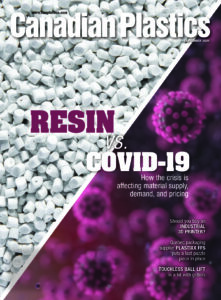
The 2020s (so far)
Noteworthy news/events: The COVID-19 pandemic; CPIA folds and becomes a division of the Chemistry Industry Association of Canada; multiple international trade shows cancelled due to the pandemic, including NPE 2021; Heartland Polymers begins production; Nova Sclairtech begins production; Niigon Technologies (formerly Athena Automation) goes out of business; Canada ratifies the United States of America, the United Mexican States, and Canada (USMCA) free trade agreement.
Profitable products: Nylon masks; C95 respirators; the Mully Cup golf ball lifter.
Significant trends and developments: Working from home and zoom meetings; increased use of automation; cloud-based software; Industry 5.0.
Hot button issues: The “Great Resignation”; single-use plastic bans take effect in Canada; plastics manufacturing declared “toxic” in Canada under CEPA; supply chain challenges; raw material shortages.
